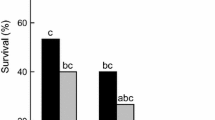Abstract
Seasonally acclimatized citrus blackfly (CBF),Aleurocanthus woglumi Ashby, and its parasite,Amitus hesperidum Silv. were exposed to extreme temperatures for 3-hour periods and survivorship measured. In summer experiments, the LD50 for CBF adults and 1st instar nymphs occurred between 40° and 45°C. The LD50 forA. hesperidum adults occurred between 35° and 40°C and increased with decreased humidity, although some adults could continue to emerge from parasitized CBF up to 45°C. In winter experiments, the LD50 for CBF eggs and adults occurred between −5° and −10°C and for other CBF stages between −10° and −15°C. The LD50 for adultA. hesperidum, and survival and emergence of the parasites from CBF both occurred between −10° and −15°C. Comparing data from the 2 seasons shows that adults are the most temperature sensitive stage of CBF and the parasite is more temperature sensitive than CBF, especially at higher temperatures. Correlating lethal temperature data with field meteorological conditions shows that short-term temperature exposures cannot be expected to stop the potential spread of CBF orA. hesperidum through Florida.
Résumé
La mouche noire des citrus,Aleurocanthus woglumi Ashby, qui apparaît en saison, et son parasiteAmitus hesperidum Silv., ont été exposés à des températures extrêmes pendant des périodes de trois heures, et leur survie a été mesurée.
Dans les expériences d'été, la DL50 pour la mouche adulte et le premier stade de la nymphe se situe entre 40 et 45°C, et la DL50 pour tous les autres stades entre 45 et 50°C. La DL50 pourAmitus hesperidum adulte est entre 35 et 40°C. Elle augmente en diminuant l'humidité, bien que quelques adultes peuvent continuer de sortir de la mouche parasitée jusqu'à 45°C.
Dans les expériences d'hiver, la DL50 pour les œufs de la mouche et la mouche adulte est entre −5 et −10°C, et pour les autres stades de la mouche entre −10 et −15°C. La DL50 pourA. hesperidum adulte, la survie et la sortie des parasites de la mouche se sont respectivement produits entre −10 et −15°C. La comparaison des données des 2 saisons indique que la mouche est plus sensible aux temperatures au stade adulte, et que le parasite est plus sensible aux températures que la mouche, particulièrement aux températures plus élevées.
La corrélation des données de température mortelle avec les conditions météorologiques dans la nature montre que les expositions de courte durée aux températures défavorables ne peuvent faire espérer l'arrêt de la propagation possible de la mouche (CBF) ou deA. hesperidum en Floride.
Similar content being viewed by others
References
Butler, C. G. — 1938. On the ecology ofAleurodes brassicae Walk. [Hemiptera]. —Trans. R. Entomol. Soc. Lond., 87, 291–311.
Cherry, R., Dowell, R. V. &Fitzpatrick, G. — 1978. Survival of immature citrus blackfly,Aleurocanthus woglumi, and its parasites,Amitus hesperidum, on excised leaves. —Environ. Entomol., 7, 28–30.
Clausen, C. P. — 1934. The natural enemies ofAleyrodidae in tropical Asia. —Philippine J. Sci., 53, 252–265.
Cooper, W. C. — 1966. Leaf temperatures of valencia orange leaves in Florida. —Proc. Fla. State Hort. Soc., 79, 66–70.
Dietz, H. F. & Zetek, J. — 1920. The blackfly of citrus and other subtropical plants. —U.S.D.A. Bull., No. 885, 55 pp.
Enkerlin, S. D. — 1974. Some aspects of the citrus blackfly (Aleurocanthus woglumi Ashby), in Mexico. —Proc. Tall Timbers Conf. Ecol. Anim. Cont. Habitat Management, No. 6, 65–76.
Flanders, S. E. — 1969.Herbert D. Smith's observations on citrus blackfly parasites in India and Mexico and correlated circumstances. —Can. Entomol., 101, 467–480.
Huffaker, C. B. &Messenger, P. S. — 1976. Theory and Practice of Biological Control. —Academic Press, New York, 788 pp.
Marth, D. &Marth, M. J. (eds.). — 1976. Florida Almanac. —West Coast Productions, Inc. St. Petersburg, Florida, 441 pp.
Newell, W. &Brown, A. C. — 1939. Eradication of the citrus blackfly in Key West, Florida. —J. Econ. Entomol., 32, 680–682.
Newman, J. E., Cooper, W. C., Reuther, W., Cahoon, G. A. &Peynado, A. — 1967. Orange fruit maturity and net heat accumulations. —Citrus Res. Center Agric. Exp. Stn., Riverside, Calif., Paper No. 1780, 127–147.
Novozhilov, K. — 1976. Biological principles for the rational use of pesticides in the integrated control of agricultural pests. In: Proc. US.-USSR Symposium. The integrated control of the arthropod, disease, and weed pests of cotton, grain, sorghum, and deciduous fruit. —Texas Agric. Exp. Stn. Pub., MP-1276, 183–193.
Quezada, J. R. — 1974. Biological control ofAleurocanthus woglumi [Homoptera: Aleyrodidae] in El Salvador. —Entomophaga 19, 243–254.
Sanchez Riviello, M., Rhode, R. H., Hart, W. G. &Lara, P. D. — 1977. Citrus blackflies: greenheuse culture on hydroponic citrus plants. —J. Econ. Entomol., 70, 808–810.
Smith, H. D., Maltby, H. L. & Jimenez, E. J. — 1964. Biological control of the citrus blackfly in Mexico. —U.S.D.A. Tech. Bull., 1311, 30 pp.
Van den Bosch, R. &Messenger, P. S. — 1973. Biological Control. —Intext, New York, 180 pp.
Wigglesworth, V. B. — 1972. The Principles of Insect Physiology. —Chapman & Hall, London., 7th ed., 827 pp.
Woglum, R. S. — 1948. The California-Arizona citrus growers campaign against the citrus blackfly in the west coast of Mexico. —The Exchange, Pest Control Cir. No. 6, 15 pp.
Author information
Authors and Affiliations
Additional information
Florida Agricultural Experiment Station Journal Series.
Rights and permissions
About this article
Cite this article
Cherry, R.H. Lethal temperatures of citrus blackflyAleurocanthus woglumi [Hom.: Aleyrodidae] and its parasite,Amitus hesperidum [Hym.: Platygasteridae] . Entomophaga 24, 35–39 (1979). https://doi.org/10.1007/BF02377507
Issue Date:
DOI: https://doi.org/10.1007/BF02377507




